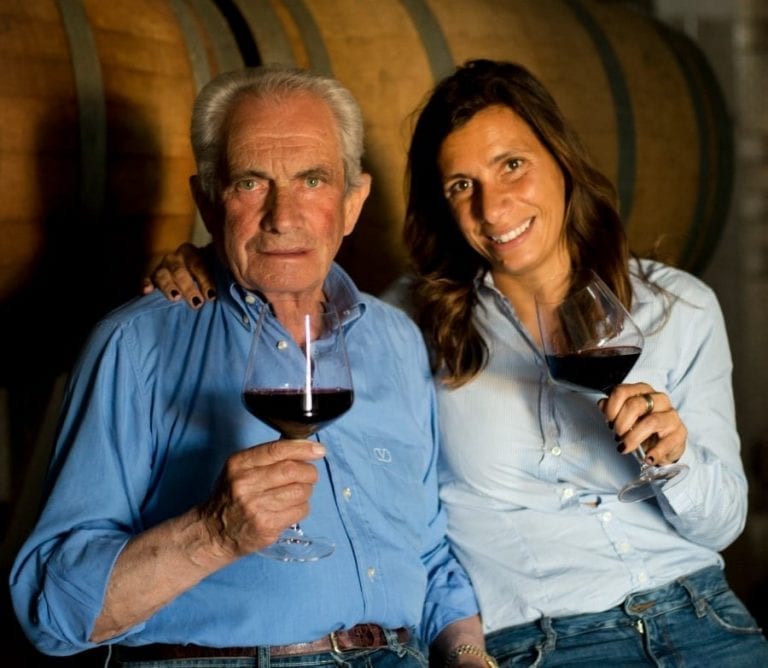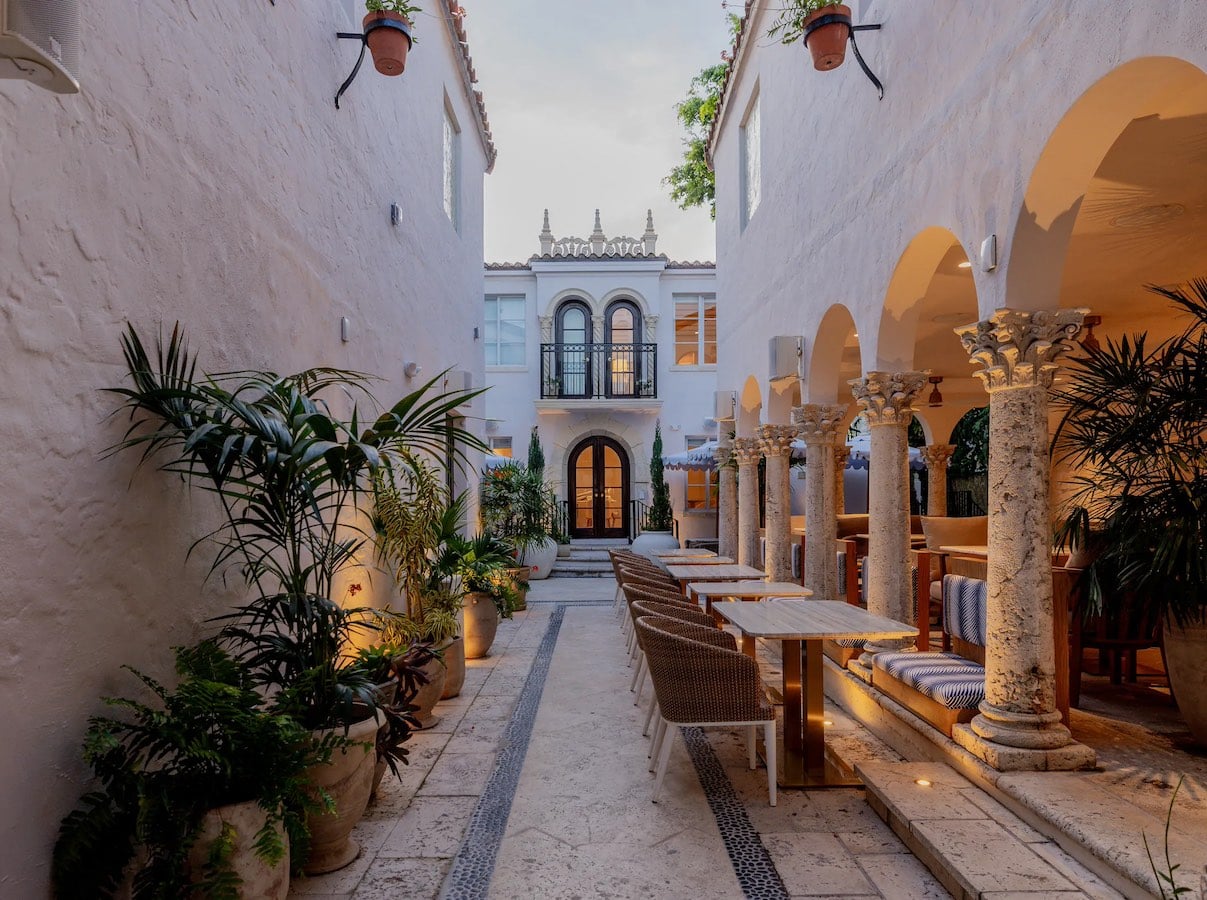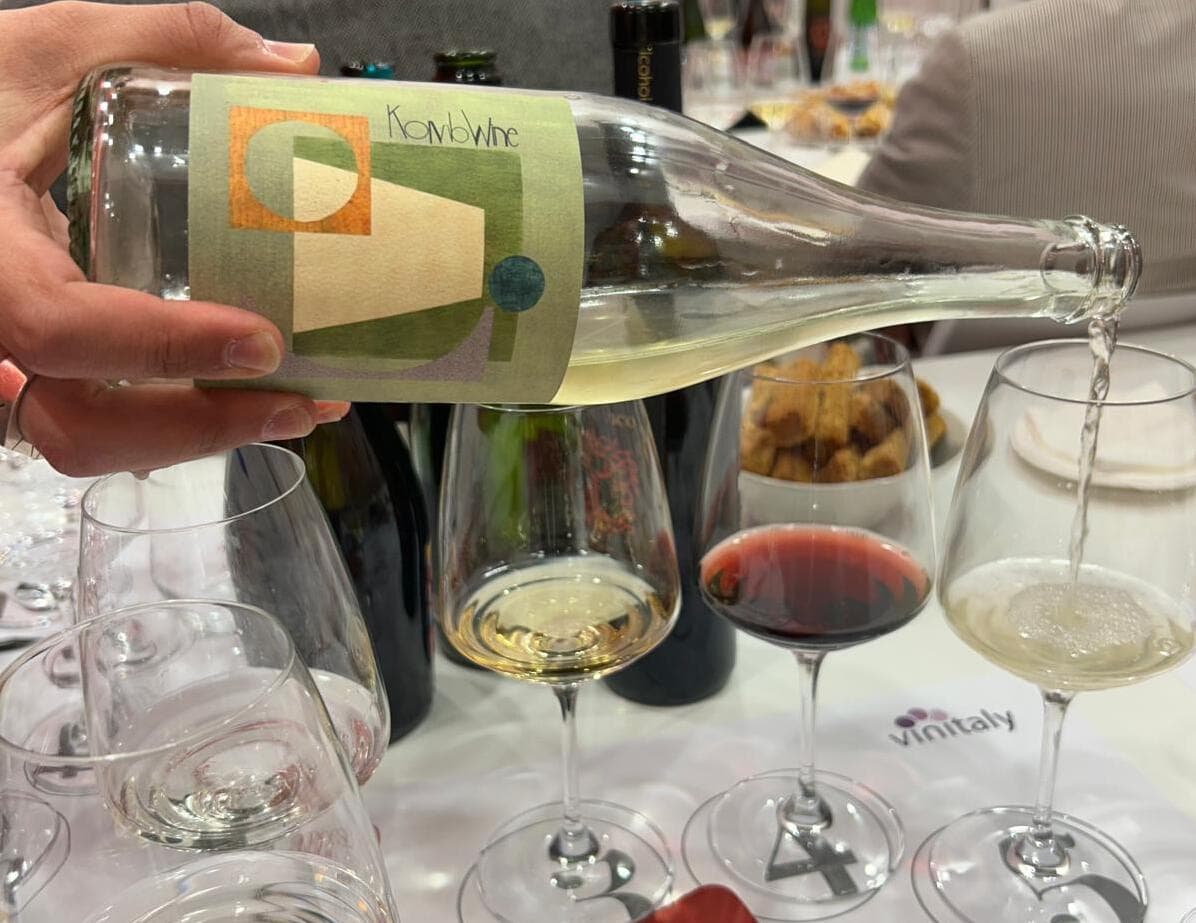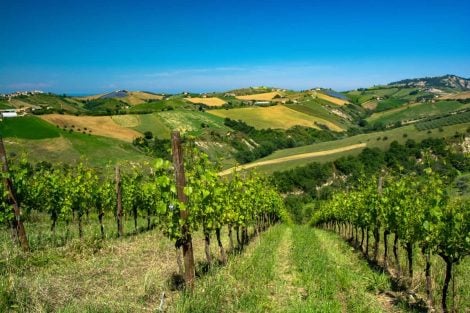It’s not easy to stand out on a stage as crowded as that of Tuscan winemaking. But Mauro Vannucci is not timid. Just the opposite. Piaggia and its wine came about almost by accident, as often happens. Mauro, an entrepreneur in a completely different sector, was looking for land on which to build a house. It was 1975, and on the plot he chose, in Poggio a Caiano, there was a vineyard. For a few years he turned it over to a farmer to cultivate. Then in 1991, the urge to make some wine for home use and the memories of childhood and family harvests in nearby Montalbano pushed him to try his own first vinification. The result was satisfying, and so, little by little, the winery grew. “The turning point came in 1993, when I met Alberto Antonini. He tasted my wine in Verona, during Vinitaly. He like the wine and I liked him.” So starting with the 1994 vintage, a fruitful collaboration began that has continued ever since. Mauro, who has his ideas about quality and is not easily satisfied, began buying land, carefully chosen with the help of Federico Curtaz, Piaggia’s agronomist. They soon had 20 hectares. “We’re in a zone that is well-suited for wine, but vineyards have to be planted carefully in the right places. Ours have a density of between 5,500 and 6,000 vines per hectare. More would be counterproductive, and fewer vines would not exploit the potential of the terroir. I’ve chosen good, well-positioned hillside exposures, well-drained galestro terrain lying between 190 and 230 meters above sea level. I planted the vines, one by one. If you don’t start in the vineyard….”
Mauro knows what he wants to express with his Carmignano – the power, richness and structure that come from healthy fruit, perfectly ripened, but at the same time he aims for elegance and drinkability. He’s not shy about comparing himself to the best. A few years ago, while visiting Château Margaux, he said to owner Paul Pontallier, “Your wine is very good, but so is mine.” The French winemaker, who died a year ago, asked him who he was and what wine he made. Mauro pulled out a bottle of his Piaggia and had Pontallier taste it. According to legend, Pontallier complimented him and asked for a bottle to drink that evening with colleagues.
“In twenty years we at Piaggia have gone far, but so has our entire zone,” said Mauro. “The area has grown, new wineries have opened, competent ecologists have come in and the market has begun to know us. Carmignano, with its Supertuscan aromas, has become more popular. My formula is 70% sangiovese, 20% cabernets franc and sauvignon, and the rest merlot. I use good quality new barrels and take extreme care with every detail, from cork cleanliness to barrel providers. Everything has to be monitored and analyzed. There are risks at every turn, and distraction can be fatal.” For the last few years, helping to build this family business, his daughter Silvia has joined him, his wife Rita, and his brother-in-law Paolo, who runs the winery. Silvia, who has a law degree, has dedicated herself passionately to Piaggia and to developing markets. “We have built up a great team, including our enologist, Emiliano Falsini. The range of our labels has grown along with our vineyards, and today we turn out more than 80,000 bottles. Alongside Piaggia Carmignano Riserva, which is our top wine, we have Carmignano del Podere Il Sasso and Poggio de’ Colli, a monovarietal Cabernet Franc that has proven to be very popular and well-received by critics. Pietranera is a fresher, bouncier Sangiovese that comes from younger vines,” Silvia told us. “At this point in our history, the problem is not selling our wine but distributing it well around the world. I love that job, and it takes me around the globe all year long, from Japan to New York, from Hawaii to London, Chicago and Canada. Sixty percent of our production is sold abroad and we’re growing little by little. The important thing,” added Silvia, who has also been the president of the Carmignano wine consortium, “is to place it in the right settings, in the best wine bars and best restaurants on the planet.” How much can the winery grow, we wondered. Silvia explained, “In terms of quantity, if we find the right vineyards, we could go over 100,000 bottles annually in the next years, but not much more.” And qualitatively? “My father has his idea of wine, and I have mine. As I travel I visit wineries and taste a great deal. I like to meet with colleagues from all over, and I bring these experiences home. My father likes challenges, and he thinks every aspect can be perfected. We’re always discussing, experimenting, trying to improve, year after year in how we interpret our territory, our vintages, the tastes of our consumers. That’s the Piaggia spirit - never be satisfied!”
Piaggia | Poggio a Caiano (PO) | www.piaggia.com
Carmignano Docg
At its base, sangiovese
The scent of a SuperTuscan
Carmignano is a town between Florence and Prato. It gives its name to a DOCG wine produced in its surrounding territory and in nearby Poggio a Caiano. Both places are in the Prato province. Sangiovese grapes must account for 50% of the vinification. Canaiolo nero grapes can amount to 20%, cabernet (franc and sauvignon) from 10 to 20%. Trebbiano toscano, canaiolo bianco and malvasia del Chianti can be added to a maximum of 10%. Regulations assert that the vineyards have to be on hillsides, the soil must be marly limestone of the alberese type, clay schist (Eocene) and sandstone (Oligocene). Altitude must not exceed 400 meters above sea level. Forcing of every kind is forbidden, but emergency irrigation is permitted. The wine requires aging at least until June 1 of the year following the harvest. It must be held in oak or chestnut barrels for at least eight months. All vinification operations, aging and bottling, have to be carried out in the DOCG zone.
Carmignano Riserva Piaggia
2013 | 93
Dark ruby red, with lovely purplish tones on the rim, the color is dark and dense. On the nose, the wine is youthful and far from being fully evolved. It offers notes of ripe red and black fruit, with blackberries, marasca cherries and plums in the foreground, which then turn to spicy, Mediterranean tones and a delicate boisé note. On the palate the wine is fat, rich and dense, but it also has backbone, freshness, and fruitiness. It offers appealing nuances of blackberry, chocolate, black currant and blueberry. Tannins are smooth and resolved, the fruit healthy and whole. Not fully developed, it needs a few years to mature in order to express its full potential. A long and fascinating close on black fruit and balsamic notes.
2012 | 94
Dark ruby red, dense, limpid. A lovely nose with ink tones, red and black fruit, a balsamic vein and notes of Mediterranean scrub. An intense wine, it is still behind in development, almost raw. The palate is dense, taut, and substantial wine, but not over-extracted; well-balanced, it has smooth tannins that are softly astringent. A tale of terroir with ripe red fruit, backbone, long aromatic persistence. Powerful and truly seductive.
2011 | 93
Dark, almost black shade of red. The nose is intense, rich, full of red and black fruit with the classic balsamic vein and a clear note of blackberry. The palate is dense, full, pulpy and fat, with notes of chocolate and smoke, but resolves into a fresh tonic feel, with a good, healthy acidic component. It is an articulated, savory wine, balanced, even if assertive, powerful and rich. A lovely soft, long finish on notes of fruit, with important but elegant tannins. The blackberry returns. Great balance of wood tones.
2010 | 95
Intense and rich ruby hue. Perfectly mature plum nose with hints of pomegranate, Mediterranean scrub, wild blackberries. The wine begins to find its dimension. Rich, pulpy, substantial, with a silhouette that lengthens and slims in a dialogue between red and black fruit. An assertive acidic vein translates into a long finish of blackberries and black currants where coffee and toasty sensations are still just an idea. Re-tasted, it is one of the richest and most complete, complex. An amazing and persistent nose. Enthralling.
2009 | 92
Dark ruby color, intense and deep, with a still unyielding rim. A Mediterranean nose of Tuscan countryside herbs and flowers, the scent of land burned by a summer sun, but also of sweet notes of blackberry and ripe plum. The bouquet is rich in medicinal herbs, like an herbalist shop. Then comes a hint of bitter cacao and a note of licorice. In the mouth, the usual majestic structure, but with the balance that time begins to confer. Notes of red fruit, of roast coffee, a touch of licorice and pepper render the mix even more fascinating and complex. A lengthy close, austere and serious, still a little marked by wood sensations.
2008 | 91
Intense, dense, taut ruby color. Dense and rich on the nose where it displays warm notes of dry, sun-warmed land, hints of hay, boisétones, toasted wood, nuances of coffee. The mouth is structured and warm, its fruit ripe and sweet – marasca cherries, blackberries and plums – then aromatic herbs, hay and summer meadow flowers. This red approaches maturity; elegant fruit, solid, wonderful astringent and imperious close. No roughness or unevenness; dense, substantial. Tannins are sweet and smooth. Notes of pepper and licorice. Wood sensations, but never too insistent. The structure is weighty without being too muscular or extracted. The year was a warm one, but the wine expresses juicy fruit. Fine tones, on the close, of wood and spice. A powerful wine but also sweetly fruity and balanced.
2006 | 93
Elegant and relaxed wine with an integral rim. Notes of fruit, incense and balsam lead into the broad, suave palate of recent years. At first, the palate is less impressive, but quickly finds rhythm and scope. An impression of forest floor and porcini mushrooms appears, with backbone and freshness supporting it all. A fresh-tasting wine that evokes the first autumnal breezes, a more intimate, self-contained story. Great elegance. On re-tasting, even better; harmonious, long and well-balanced.
2005 | 95
Dark, dense ruby color. Spectacular. Its expressive force and vitality make it seem a more recent vintage. Elegant, taut and concentrated at first, harmonious and generous. It is the first of these vintages to have a balanced character of real, vital maturity. Red and black fruits are in the foreground, ripe but not too much so, with blackberry, blueberry, raspberry and cherry appearing in succession. Fine boisébackground, good density offering substance from the first impact to the delicate but peremptory final note where cherry finally gives way to coffee and licorice with some assertiveness. Elegant, full, rich and long. One of the best Piaggia vintages ever.
2003 | 90
Dark ruby red with a hint of evolution on the rim. On the nose, chocolate and spice, aromatic herbs and quinine, which lead into plum and marasca cherry jam. Then come darker tones – coffee and spices, fireplace and aromatic wood. The palate is well expressed, generous, warm, mouth-filling and progressive. A hot vintage year, but interpreted with class and discretion, without sacrificing drinkability and balance. Sapidity, elegant tannins, a measured and balanced astringent vein that translates into a long, spicy, balsamic, balanced finish with notes of pepper and summery forest floor. Still healthy and taut.
2002 | 92
Dark ruby color, slight evolved shade on the rim. The first…. Elegant nose of berries, Mediterranean scrub, but also a note of vanilla. An amazingly suave and slim vintage year in the history of this wine. It doesn’t lack concentration, but is deliciously relaxed, in a minor key, with enviable balance and a promise of longevity. On the palate, spicy, fine, elegant notes. Wood is consistent, and the mouth has a good rhythmic cadence that underlines the peculiarities of the vintage year. It closes smoothly and long on notes of cherry, hay and aromatic herbs. Mature but not overly so. A marching, unstoppable pace.
2001 | 97
Impressive. Black, dark, deep. a wine that unleashes power and energy extraordinary for its age. Concentration and structure are at the limits of arrogance. It is powerful, vibrant, concentrated. Truly muscular, substantial, intense. It could be the undoing of a commonplace formula, but instead it is the glorification of a wonderful vintage an exceptional terroir. It is the result of care that doesn’t overlook a single plant in the vineyard. A great Italian red – powerful, mouth-filling, complex and richly multifaceted, qualities that others of this age lack. Impressive for elegance and sunny Mediterranean style. One of the high points in the brief history of this young winery. At the limits of the unforgettable.
2000 | 94
Classic ruby color, dense, dark, intense. Nose is substantial and complex with spice and pleasant wood sensations, clear and harmonious. Ripe red and black fruit, whole and healthy. Even if the vintage year was hot, ripening fruit to the limit, the wine has balance and finesse. Acidic freshness and measured extraction of tannins make this vintage year a benchmark. Medicinal herbs, bouquet garni, tones of marasca cherries and roast lamb describe a red that is dense, elegant, rhythmic. Mature and never dusty tannins. The close is on opulent, ripe fruit and white pepper. A grand interpretation of a hot year. Harmonious, balanced and dynamic. Coffee, hazelnut, licorice and toast at the end.
1999 | 95
Mentholated tones of licorice, quinine and Cuban cigar tobacco introduce us to an elegant, taut, muscular wine of grace, harmony and amazing persistence, a jewel of power and balance. Dense but relaxed, it unfurls seductive, caressingly soft tannins. On the palate it is truly long and persistent, with a finish of tobacco and then mint, thyme and marjoram, enchantingly mixed with sensations of cherry and blackberry. One of the most seductive and elegant vintages, it is balsamic, complex and empyreumatic, but still has full, taut fruitiness.
1998 | 92
At first, scents of marasca cherries and medicinal herbs, then a relaxed, elegant and dense nose with tones of quinine bark, porcini mushrooms and forest floor, shading into bouquet garni. The palate is substantial, pulpy, with elegant, savory, taut fruit. A Mediterranean, warm and mouth-filling wine, it has warmth and density, and is fruity and delicately astringent, with remarkably smooth and caressing tannins. Hints of chocolate, coffee, wild blackberries and sour cherries. Vital, dynamic, harmonious, it is one of the proofs that time bestows only elegance on this wine. Rigorous balance and rhythm, extraordinarily satisfying.
1997
From a hot vintage year, it is a wine with evolved tones, delicately tertiary, of forest floor, porcini mushrooms and truffles. An acidic vein supports a scaffolding that is beginning to show some cracks here and there. Today the wine has a lovely autumnal tone of forest floor and an acidic tone emerges. For years it held out, thanks to its concentration, alcohol and richness, but in the long run, the waves of August heat of that year affected the balance and integrity of the fruit. A handsome example, but it faces the inconvenience of being compared with other vintage years of the same wine.
1996 | 94
Elegant, ripe, fresh, fruity, substantial and dense. This is a 20-year old wine in an ideal state of evolution and development. Fruit is still tonic, its character has just barely evolved, but it is full-flavored and dense, with astonishing freshness and creaminess. Blackberries and plum, spices and fresh aromatic herbs underline its elegant and balanced Mediterranean character. Clearly Tuscan, it also has an international tone. A wonderful play of wood sensations, great freshness and expressive rhythms. Tannins are velvety and mouth-filling. The wine is clean, pulpy and still fresh on the palate. It has delicate elegance, reassuring power, and displays a rich palette of sensations that only age can give and is finally displaying. Twenty years old. Marvelous.
1995 | 90
Chocolate, licorice, spices, pine bark, balsamic notes on the nose.
Sweet, soft, meaty and rich, it is balanced in the mouth, with hints of coffee, candied orange peel, bitter chocolate, cherry and blackberry jam that make it complex and intriguing. Velvety tannins and a vein of fresh acidity sustain the fruit. A healthy wine that still moves ahead, with an elegant and substantial finish, soft and fine. A wonderful surprise.
1994 | 90
Texture, density, harmony, elegance. It has fruit, substance, freshness and finesse. Tertiary notes on color that is still compact and integral, a marvel of harmony and elegance. There’s structure, a careful use of wood, a complex bouquet of spices, roasting coffee and elegant balsamic notes. At the end, it all resolves into a rich harmony, in constant, unfettered rhythm and a finish that is warm, satisfying and sunny, telling of Tuscany, Carmignano and Piaggia. Long, full and rigorous, it is also pleasantly caressing. Bravo.
by Marco Sabellico



 Versace opens a super hotel with an Italian restaurant. Here's what Donatella Hotel & Restaurant in Miami will be like
Versace opens a super hotel with an Italian restaurant. Here's what Donatella Hotel & Restaurant in Miami will be like At The Crown Tirana, service and quality at the highest levels
At The Crown Tirana, service and quality at the highest levels We tasted Komb(w)ine, the new product that combines grape must and kombucha. Here’s our verdict
We tasted Komb(w)ine, the new product that combines grape must and kombucha. Here’s our verdict What changes for the export of Italian wines to China under the new regulations?
What changes for the export of Italian wines to China under the new regulations? “Forget dealcoholised wines. The future is Komb(w)ine.” Moser and Ravizza present a new grape must-based product
“Forget dealcoholised wines. The future is Komb(w)ine.” Moser and Ravizza present a new grape must-based product






